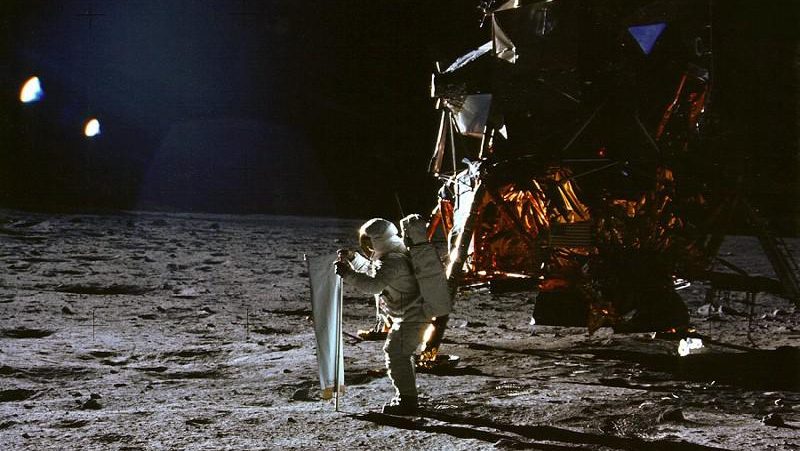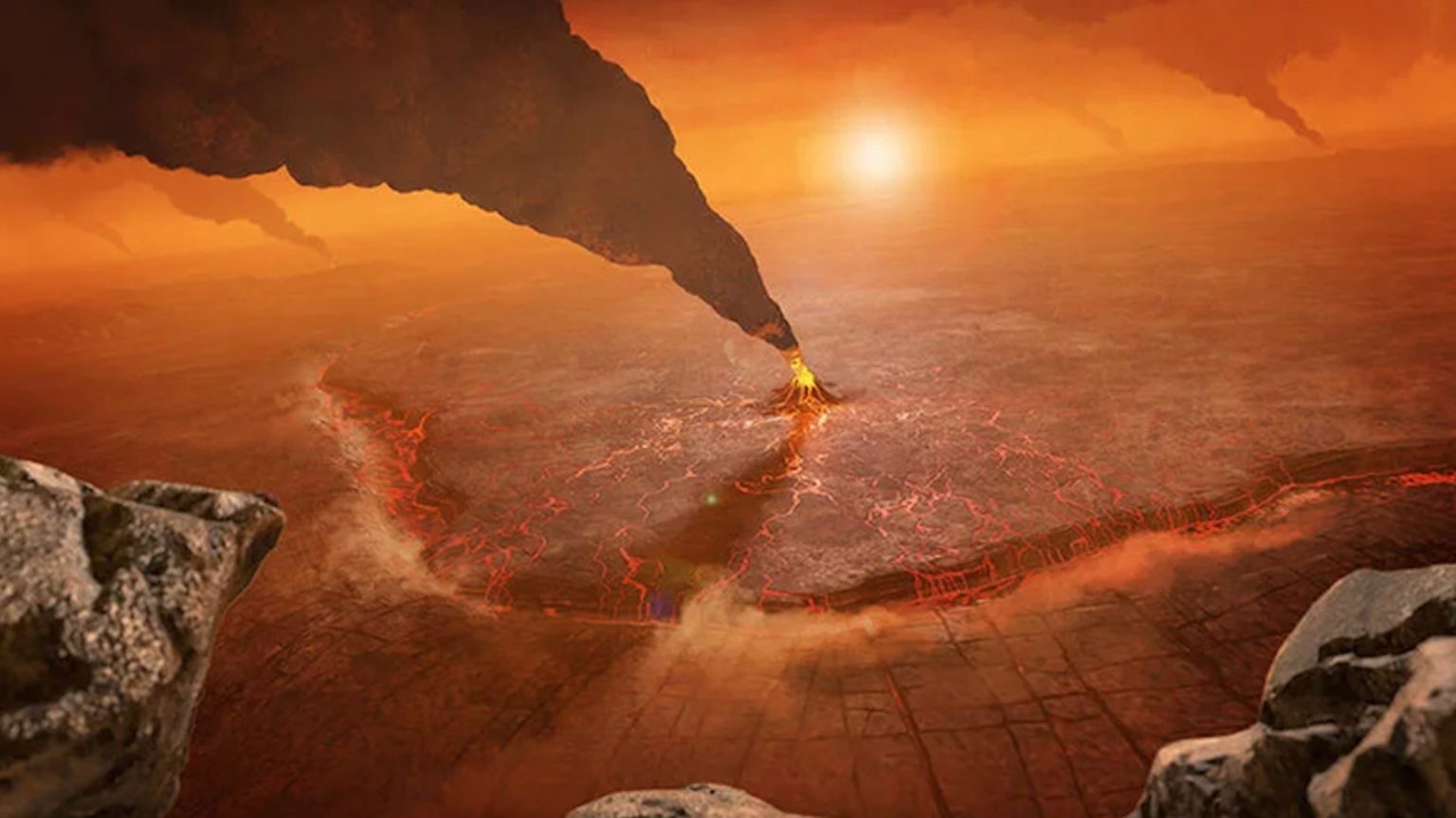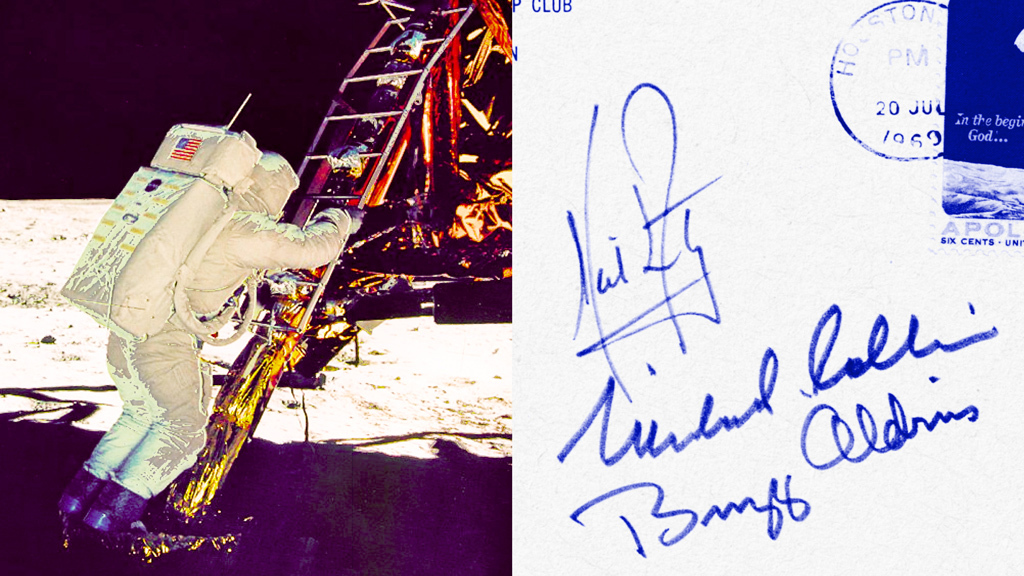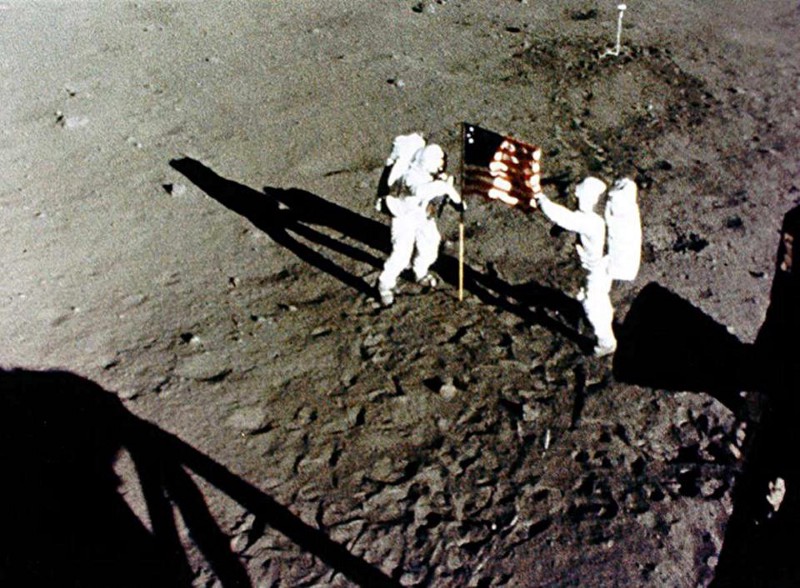‘Apollo 11 in Real Time’ website replays every second of historic mission

- The website includes lets viewers experience the mission through 11,000 hours of audio, thousands of photographs and multiple camera angles.
- Apollo 11 lasted just over eight days.
- Only 12 men have walked on the Moon so far. NASA plans to return to the lunar surface in 2024.
Today — July 16, 2019 — marks the 50th anniversary of the launch of Apollo 11, the mission that first landed a man on the Moon. Hundreds of Apollo-themed celebrations are happening across the U.S. this week, from museum exhibits to choreographed miniature rocket launches to tours of the newly restored Apollo Mission Control Room. But one of the most interesting commemorations of the historic mission is happening online.
Apollo 11 in Real Time is a “mission experience” a website, created by Ben Feist, that replays the Apollo 11 mission second by second, starting with archival footage and audio taken 20 hours before launch, and ending just after Neil Armstrong, Buzz Aldrin and Michael Collins step onto the USS Hornet recovery ship. The website lets viewers switch between multiple camera angles and also includes:
- All mission control film footage
- All TV transmissions and onboard film footage
- 2,000 photographs
- 11,000 hours of Mission Control audio
- 240 hours of space-to-ground audio
- All onboard recorder audio
- 15,000 searchable utterances
- Post-mission commentary
- Astromaterials sample data
“With the help of archivist Stephen Slater, the website is the most complete presentation of the mission’s historical film footage ever assembled,” Feist told CollectSpace.com. “It contains all of the 16mm film that was scanned for the recent documentary, ‘Apollo 11.’ Much of this film has had sound added to it for the first time — painstakingly lip synced with the restored mission control audio that was just digitized.”
Feist said viewers are virtually guaranteed to see and hear things they’ve never heard before.
“Running through the entire mission is very rewarding,” he said. “You really get to know the personalities of the crew and controllers. It feels very current — as though it’s happening right now.
During the anniversary, clicking the ‘Now’ launch button will drop you into the mission exactly 50 years later, to the second…If I had my way, all of humanity would take a moment out of their busy lives, tune in and marvel at the scale of what humanity can achieve when we all work together.”
After blasting off from the Kennedy Space Center on the Saturn V rocket, the Apollo 11 spent three days traveling to the Moon, entering lunar orbit on July 19. But only Aldrin and Armstrong were headed for the lunar surface in NASA’s lunar module called the Eagle, while Collins stayed aboard the Columbia — a task he felt honored to perform but still made him feel “absolutely isolated from any known life.”
“I am it. If a count were taken, the score would be three billion plus two over on the other side of the Moon, and one plus God knows what on this side.”
Armstrong and Aldrin spent more than two hours on the lunar surface, collecting ground samples and deploying scientific equipment, before launching off the Moon in the Eagle’s ascent stage, eventually rejoining Collins aboard the Columbia. The trio finally returned to Earth on July 24, having spent more than eight days in space. For a more detailed look at the mission, check out NASA’s Apollo 11 mission timeline listed below:
Apollo 11 Timeline
|
Event |
GET (hhh:mm:ss) |
GMT Time |
GMT Date |
|
Terminal countdown started. |
-028:00:00 |
21:00:00 |
14 Jul 1969 |
|
Scheduled 11-hour hold at T-9 hours. |
-009:00:00 |
16:00:00 |
15 Jul 1969 |
|
Countdown resumed at T-9 hours. |
-009:00:00 |
03:00:00 |
16 Jul 1969 |
|
Scheduled 1-hour 32-minute hold at T-3 hours 30 minutes. |
-003:30:00 |
08:30:00 |
16 Jul 1969 |
|
Countdown resumed at T-3 hours 30 minutes. |
-003:30:00 |
10:02:00 |
16 Jul 1969 |
|
Guidance reference release. |
-000:00:16.968 |
13:31:43 |
16 Jul 1969 |
|
S-IC engine start command. |
-000:00:08.9 |
13:31:51 |
16 Jul 1969 |
|
S-IC engine ignition (#5). |
-000:00:06.4 |
13:31:53 |
16 Jul 1969 |
|
All S-IC engines thrust OK. |
-000:00:01.6 |
13:31:58 |
16 Jul 1969 |
|
Range zero. |
000:00:00.00 |
13:32:00 |
16 Jul 1969 |
|
All holddown arms released (1st motion). |
000:00:00.3 |
13:32:00 |
16 Jul 1969 |
|
Liftoff (umbilical disconnected) (1.07 g). |
000:00:00.63 |
13:32:00 |
16 Jul 1969 |
|
Tower clearance yaw maneuver started. |
000:00:01.7 |
13:32:01 |
16 Jul 1969 |
|
Yaw maneuver ended. |
000:00:09.7 |
13:32:09 |
16 Jul 1969 |
|
Pitch and roll maneuver started. |
000:00:13.2 |
13:32:13 |
16 Jul 1969 |
|
Roll maneuver ended. |
000:00:31.1 |
13:32:31 |
16 Jul 1969 |
|
Mach 1 achieved. |
000:01:06.3 |
13:33:06 |
16 Jul 1969 |
|
Maximum dynamic pressure (735.17 lb/ft2). |
000:01:23.0 |
13:33:23 |
16 Jul 1969 |
|
Maximum bending moment (33,200,000 lbf-in). |
000:01:31.5 |
13:33:31 |
16 Jul 1969 |
|
S-IC center engine cutoff command. |
000:02:15.2 |
13:34:15 |
16 Jul 1969 |
|
Pitch maneuver ended. |
000:02:40.0 |
13:34:40 |
16 Jul 1969 |
|
S-IC outboard engine cutoff. |
000:02:41.63 |
13:34:41 |
16 Jul 1969 |
|
S-IC maximum total inertial acceleration (3.94 g). |
000:02:41.71 |
13:34:41 |
16 Jul 1969 |
|
S-IC maximum Earth-fixed velocity. S-IC/S-II separation command. |
000:02:42.30 |
13:34:42 |
16 Jul 1969 |
|
S-II engine start command. |
000:02:43.04 |
13:34:43 |
16 Jul 1969 |
|
S-II ignition. |
000:02:44.0 |
13:34:44 |
16 Jul 1969 |
|
S-II aft interstage jettisoned. |
000:03:12.3 |
13:35:12 |
16 Jul 1969 |
|
Launch escape tower jettisoned. |
000:03:17.9 |
13:35:17 |
16 Jul 1969 |
|
Iterative guidance mode initiated. |
000:03:24.1 |
13:35:24 |
16 Jul 1969 |
|
S-IC apex. |
000:04:29.1 |
13:36:29 |
16 Jul 1969 |
|
S-II center engine cutoff. |
000:07:40.62 |
13:39:40 |
16 Jul 1969 |
|
S-II maximum total inertial acceleration (1.82 g). |
000:07:40.70 |
13:39:40 |
16 Jul 1969 |
|
S-IC impact (theoretical). |
000:09:03.7 |
13:41:03 |
16 Jul 1969 |
|
S-II outboard engine cutoff. |
000:09:08.22 |
13:41:08 |
16 Jul 1969 |
|
S-II maximum Earth-fixed velocity. S-II/S-IVB separation command. |
000:09:09.00 |
13:41:09 |
16 Jul 1969 |
|
S-IVB 1st burn start command. |
000:09:09.20 |
13:41:09 |
16 Jul 1969 |
|
S-IVB 1st burn ignition. |
000:09:12.20 |
13:41:12 |
16 Jul 1969 |
|
S-IVB ullage case jettisoned. |
000:09:21.0 |
13:41:21 |
16 Jul 1969 |
|
S-II apex. |
000:09:47.0 |
13:41:47 |
16 Jul 1969 |
|
S-IVB 1st burn cutoff. |
000:11:39.33 |
13:43:39 |
16 Jul 1969 |
|
S-IVB 1st burn maximum total inertial acceleration (0.69 g). |
000:11:39.41 |
13:43:39 |
16 Jul 1969 |
|
Earth orbit insertion. S-IVB 1st burn maximum Earth-fixed velocity. |
000:11:49.33 |
13:43:49 |
16 Jul 1969 |
|
Maneuver to local horizontal attitude started. |
000:11:59.3 |
13:43:59 |
16 Jul 1969 |
|
Orbital navigation started. |
000:13:21.1 |
13:45:21 |
16 Jul 1969 |
|
S-II impact (theoretical). |
000:20:13.7 |
13:52:13 |
16 Jul 1969 |
|
S-IVB 2nd burn restart preparation. |
002:34:38.2 |
16:06:38 |
16 Jul 1969 |
|
S-IVB 2nd burn restart command. |
002:44:08.2 |
16:16:08 |
16 Jul 1969 |
|
S-IVB 2nd burn ignition (STDV open). |
002:44:16.2 |
16:16:16 |
16 Jul 1969 |
|
S-IVB 2nd burn cutoff. |
002:50:03.03 |
16:22:03 |
16 Jul 1969 |
|
S-IVB 2nd burn maximum total inertial acceleration (1.45 g). |
002:50:03.11 |
16:22:03 |
16 Jul 1969 |
|
S-IVB 2nd burn maximum Earth-fixed velocity. |
002:50:03.5 |
16:22:03 |
16 Jul 1969 |
|
S-IVB safing procedures started. |
002:50:03.8 |
16:22:03 |
16 Jul 1969 |
|
Translunar injection. |
002:50:13.03 |
16:22:13 |
16 Jul 1969 |
|
Maneuver to local horizontal attitude started. |
002:50:23.0 |
16:22:23 |
16 Jul 1969 |
|
Orbital navigation started. |
002:50:23.9 |
16:22:23 |
16 Jul 1969 |
|
Maneuver to transposition and docking attitude started. |
003:05:03.9 |
16:37:03 |
16 Jul 1969 |
|
CSM separated from S-IVB. |
003:15:23.0 |
16:47:23 |
16 Jul 1969 |
|
CSM separation maneuver ignition. |
003:17:04.6 |
16:49:04 |
16 Jul 1969 |
|
CSM separation maneuver cutoff. |
003:17:11.7 |
16:49:11 |
16 Jul 1969 |
|
CSM docked with LM/S-IVB. |
003:24:03.7 |
16:56:03 |
16 Jul 1969 |
|
CSM/LM ejected from S-IVB. |
004:17:03.0 |
17:49:03 |
16 Jul 1969 |
|
CSM/LM evasive maneuver from S-IVB ignition. |
004:40:01.72 |
18:12:01 |
16 Jul 1969 |
|
CSM/LM evasive maneuver from S-IVB cutoff. |
004:40:04.65 |
18:12:04 |
16 Jul 1969 |
|
S-IVB maneuver to lunar slingshot attitude initiated. |
004:41:07.6 |
18:13:07 |
16 Jul 1969 |
|
S-IVB lunar slingshot maneuver – LH2 tank CVS opened. |
004:51:07.7 |
18:23:07 |
16 Jul 1969 |
|
S-IVB lunar slingshot maneuver – LOX dump started. |
005:03:07.6 |
18:35:07 |
16 Jul 1969 |
|
S-IVB lunar slingshot maneuver – LOX dump ended. |
005:04:55.8 |
18:36:55 |
16 Jul 1969 |
|
S-IVB lunar slingshot maneuver – APS ignition. |
005:37:47.6 |
19:09:47 |
16 Jul 1969 |
|
S-IVB lunar slingshot maneuver – APS cutoff. |
005:42:27.8 |
19:14:27 |
16 Jul 1969 |
|
S-IVB maneuver to communications attitude initiated. |
005:42:48.8 |
19:14:48 |
16 Jul 1969 |
|
TV transmission started (recorded at Goldstone and transmitted to Houston at 011:26). |
010:32 |
00:04 |
17 Jul 1969 |
|
TV transmission ended. |
010:48 |
00:20 |
17 Jul 1969 |
|
Midcourse correction ignition. |
026:44:58.64 |
16:16:58 |
17 Jul 1969 |
|
Midcourse correction cutoff. |
026:45:01.77 |
16:17:01 |
17 Jul 1969 |
|
TV transmission started. |
030:28 |
20:00 |
17 Jul 1969 |
|
TV transmission ended. |
031:18 |
20:50 |
17 Jul 1969 |
|
TV transmission started. |
033:59 |
23:31 |
17 Jul 1969 |
|
TV transmission ended. |
034:35 |
00:07 |
18 Jul 1969 |
|
TV transmission started. |
055:08 |
20:40 |
18 Jul 1969 |
|
CDR and LMP entered LM for initial inspection. |
055:30 |
21:02 |
18 Jul 1969 |
|
TV transmission ended. |
056:44 |
22:16 |
18 Jul 1969 |
|
CDR and LMP entered CM. |
057:55 |
23:27 |
18 Jul 1969 |
|
Equigravisphere. |
061:39:55 |
03:11:55 |
19 Jul 1969 |
|
Lunar orbit insertion ignition. |
075:49:50.37 |
17:21:50 |
19 Jul 1969 |
|
Lunar orbit insertion cutoff. |
075:55:47.90 |
17:27:47 |
19 Jul 1969 |
|
Sighting of an illumination in the Aristarchus region. 1st time, a lunar transient event sighted by an observer in space. |
077:13 |
18:45 |
19 Jul 1969 |
|
TV transmission started. |
078:20 |
19:52 |
19 Jul 1969 |
|
S-IVB closest approach to lunar surface. |
078:42 |
20:14 |
19 Jul 1969 |
|
TV transmission ended. |
079:00 |
20:32 |
19 Jul 1969 |
|
Lunar orbit circularization ignition. |
080:11:36.75 |
21:43:36 |
19 Jul 1969 |
|
Lunar orbit circularization cutoff. |
080:11:53.63 |
21:43:53 |
19 Jul 1969 |
|
LMP entered CM for initial power-up and system checks. |
081:10 |
22:42 |
19 Jul 1969 |
|
LMP entered CM. |
083:35 |
01:07 |
20 Jul 1969 |
|
CDR and LMP entered LM for final preparations for descent. |
095:20 |
12:52 |
20 Jul 1969 |
|
LMP entered CM. |
097:00 |
14:32 |
20 Jul 1969 |
|
LMP entered LM. |
097:30 |
15:02 |
20 Jul 1969 |
|
LM system checks started. |
097:45 |
15:17 |
20 Jul 1969 |
|
LM system checks ended. |
100:00 |
17:32 |
20 Jul 1969 |
|
CSM/LM undocked. |
100:12:00.0 |
17:44:00 |
20 Jul 1969 |
|
CSM/LM separation maneuver ignition. |
100:39:52.9 |
18:11:52 |
20 Jul 1969 |
|
CSM/LM separation maneuver cutoff. |
100:40:01.9 |
18:12:01 |
20 Jul 1969 |
|
LM descent orbit insertion ignition (LM SPS). |
101:36:14 |
19:08:14 |
20 Jul 1969 |
|
LM descent orbit insertion cutoff. |
101:36:44 |
19:08:44 |
20 Jul 1969 |
|
LM acquisition of data. |
102:17:17 |
19:49:17 |
20 Jul 1969 |
|
LM landing radar on. |
102:20:53 |
19:52:53 |
20 Jul 1969 |
|
LM abort guidance aligned to primary guidance. |
102:24:40 |
19:56:40 |
20 Jul 1969 |
|
LM yaw maneuver to obtain improved communications. |
102:27:32 |
19:59:32 |
20 Jul 1969 |
|
LM altitude 50,000 feet. |
102:32:55 |
20:04:55 |
20 Jul 1969 |
|
LM propellant settling firing started. |
102:32:58 |
20:04:58 |
20 Jul 1969 |
|
LM powered descent engine ignition. |
102:33:05.01 |
20:05:05 |
20 Jul 1969 |
|
LM fixed throttle position. |
102:33:31 |
20:05:31 |
20 Jul 1969 |
|
LM face-up maneuver completed. |
102:37:59 |
20:09:59 |
20 Jul 1969 |
|
LM 1202 alarm. |
102:38:22 |
20:10:22 |
20 Jul 1969 |
|
LM radar updates enabled. |
102:38:45 |
20:10:45 |
20 Jul 1969 |
|
LM altitude less than 30,000 feet and velocity less than 2,000 feet per second (landing radar velocity update started). |
102:38:50 |
20:10:50 |
20 Jul 1969 |
|
LM 1202 alarm. |
102:39:02 |
20:11:02 |
20 Jul 1969 |
|
LM throttle recovery. |
102:39:31 |
20:11:31 |
20 Jul 1969 |
|
LM approach phase entered. |
102:41:32 |
20:13:32 |
20 Jul 1969 |
|
LM landing radar antenna to position 2. |
102:41:37 |
20:13:37 |
20 Jul 1969 |
|
LM attitude hold mode selected (check of LM handling qualities). |
102:41:53 |
20:13:53 |
20 Jul 1969 |
|
LM automatic guidance enabled. |
102:42:03 |
20:14:03 |
20 Jul 1969 |
|
LM 1201 alarm. |
102:42:18 |
20:14:18 |
20 Jul 1969 |
|
LM landing radar switched to low scale. |
102:42:19 |
20:14:19 |
20 Jul 1969 |
|
LM 1202 alarm. |
102:42:43 |
20:14:43 |
20 Jul 1969 |
|
LM 1202 alarm. |
102:42:58 |
20:14:58 |
20 Jul 1969 |
|
LM landing point redesignation. |
102:43:09 |
20:15:09 |
20 Jul 1969 |
|
LM altitude hold. |
102:43:13 |
20:15:13 |
20 Jul 1969 |
|
LM abort guidance attitude updated. |
102:43:20 |
20:15:20 |
20 Jul 1969 |
|
LM rate of descent landing phase entered. |
102:43:22 |
20:15:22 |
20 Jul 1969 |
|
LM landing radar data not good. |
102:44:11 |
20:16:11 |
20 Jul 1969 |
|
LM landing data good. |
102:44:21 |
20:16:21 |
20 Jul 1969 |
|
LM fuel low-level quantity light. |
102:44:28 |
20:16:28 |
20 Jul 1969 |
|
LM landing radar data not good. |
102:44:59 |
20:16:59 |
20 Jul 1969 |
|
LM landing radar data good. |
102:45:03 |
20:17:03 |
20 Jul 1969 |
|
1st evidence of surface dust disturbed by descent engine. |
102:44:35 |
20:16:35 |
20 Jul 1969 |
|
LM lunar landing. |
102:45:39.9 |
20:17:39 |
20 Jul 1969 |
|
LM powered descent engine cutoff. |
102:45:41.40 |
20:17:41 |
20 Jul 1969 |
|
Decision made to proceed with EVA prior to first rest period. |
104:40:00 |
22:12:00 |
20 Jul 1969 |
|
Preparation for EVA started. |
106:11:00 |
23:43:00 |
20 Jul 1969 |
|
EVA started (hatch open). |
109:07:33 |
02:39:33 |
21 Jul 1969 |
|
CDR completely outside LM on porch. |
109:19:16 |
02:51:16 |
21 Jul 1969 |
|
Modular equipment stowage assembly deployed (CDR). |
109:21:18 |
02:53:18 |
21 Jul 1969 |
|
First clear TV picture received. |
109:22:00 |
02:54:00 |
21 Jul 1969 |
|
CDR at foot of ladder (starts to report, then pauses to listen). |
109:23:28 |
02:55:28 |
21 Jul 1969 |
|
CDR at foot of ladder and described surface as “almost like a powder.” |
109:23:38 |
02:55:38 |
21 Jul 1969 |
|
1st step taken lunar surface (CDR). “That’s one small step for a man…one giant leap for mankind.” |
109:24:15 |
02:56:15 |
21 Jul 1969 |
|
CDR started surface examination and description, assessed mobility and described effects of LM descent engine. |
109:24:48 |
02:56:48 |
21 Jul 1969 |
|
CDR ended surface examination. LMP started to send down camera. |
109:26:54 |
02:58:54 |
21 Jul 1969 |
|
Camera installed on RCU bracket, LEC stored on secondary strut of LM landing gear. |
109:30:23 |
03:02:23 |
21 Jul 1969 |
|
Surface photography (CDR). |
109:30:53 |
03:02:53 |
21 Jul 1969 |
|
Contingency sample collection started (CDR). |
109:33:58 |
03:05:58 |
21 Jul 1969 |
|
Contingency sample collection ended (CDR). |
109:37:08 |
03:09:08 |
21 Jul 1969 |
|
LMP started egress from LM. |
109:39:57 |
03:11:57 |
21 Jul 1969 |
|
LMP at top of ladder. Descent photographed by CDR. |
109:41:56 |
03:13:56 |
21 Jul 1969 |
|
LMP on lunar surface. |
109:43:16 |
03:15:16 |
21 Jul 1969 |
|
Surface examination and examination of landing effects on surface and on LM started (CDR, LMP). |
109:43:47 |
03:15:47 |
21 Jul 1969 |
|
Insulation removed from modular equipment stowage assembly (CDR). |
109:49:06 |
03:21:06 |
21 Jul 1969 |
|
TV camera focal distance adjusted (CDR). |
109:51:35 |
03:23:35 |
21 Jul 1969 |
|
Plaque unveiled (CDR). |
109:52:19 |
03:24:19 |
21 Jul 1969 |
|
Plaque read (CDR). |
109:52:40 |
03:24:40 |
21 Jul 1969 |
|
TV camera redeployed. Panoramic TV view started (CDR). |
109:59:28 |
03:31:28 |
21 Jul 1969 |
|
TV camera placed in final deployment position (CDR). |
110:02:53 |
03:34:53 |
21 Jul 1969 |
|
Solar wind composition experiment deployed (LMP). |
110:03:20 |
03:35:20 |
21 Jul 1969 |
|
United States flag deployed (CDR, LMP). |
110:09:43 |
03:41:43 |
21 Jul 1969 |
|
Evaluation of surface mobility started (LMP). |
110:13:15 |
03:45:15 |
21 Jul 1969 |
|
Evaluation of surface mobility end (LMP). |
110:16:02 |
03:48:02 |
21 Jul 1969 |
|
Presidential message from White House and response from CDR. |
110:16:30 |
03:48:30 |
21 Jul 1969 |
|
Presidential message and CDR response ended. |
110:18:21 |
03:50:21 |
21 Jul 1969 |
|
Evaluation of trajectory of lunar soil when kicked (LMP) and bulk sample collection started (CDR). |
110:20:06 |
03:52:06 |
21 Jul 1969 |
|
Evaluation of visibility in lunar sunlight (LMP). |
110:10:24 |
03:42:24 |
21 Jul 1969 |
|
Evaluation of thermal effects of sun and shadow inside the suit (LMP). |
110:25:09 |
03:57:09 |
21 Jul 1969 |
|
Evaluation of surface shadows and colors (LMP). |
110:28:22 |
04:00:22 |
21 Jul 1969 |
|
LM landing gear inspection and photography (LMP). |
110:34:13 |
04:06:13 |
21 Jul 1969 |
|
Bulk sample completed (CDR). |
110:35:36 |
04:07:36 |
21 Jul 1969 |
|
LM landing gear inspection and photography (CDR, LMP). |
110:46:36 |
04:18:36 |
21 Jul 1969 |
|
Scientific equipment bay doors opened. |
110:53:38 |
04:25:38 |
21 Jul 1969 |
|
Passive seismometer deployed. |
110:55:42 |
04:27:42 |
21 Jul 1969 |
|
Lunar ranging retroreflector deployed (CDR). |
111:03:57 |
04:35:57 |
21 Jul 1969 |
|
1st passive seismic experiment data received on Earth. |
111:08:39 |
04:40:39 |
21 Jul 1969 |
|
Collection of documented samples started (CDR/LMP). |
111:11 |
04:43 |
21 Jul 1969 |
|
Solar wind composition experiment retrieved (LMP) . |
111:20 |
04:52 |
21 Jul 1969 |
|
LMP inside LM. |
111:29:39 |
05:01:39 |
21 Jul 1969 |
|
Transfer of sample containers reported complete. |
111:35:51 |
05:07:51 |
21 Jul 1969 |
|
CDR inside LM, assisted and monitored by LMP. |
111:37:32 |
05:09:32 |
21 Jul 1969 |
|
EVA ended (hatch closed). |
111:39:13 |
05:11:13 |
21 Jul 1969 |
|
LM equipment jettisoned. |
114:05 |
07:37 |
21 Jul 1969 |
|
LM lunar liftoff ignition (LM APS). |
124:22:00.79 |
17:54:00 |
21 Jul 1969 |
|
LM orbit insertion cutoff. |
124:29:15.67 |
18:01:15 |
21 Jul 1969 |
|
Coelliptic sequence initiation ignition. |
125:19:35 |
18:51:35 |
21 Jul 1969 |
|
Coelliptic sequence initiation cutoff. |
125:20:22 |
18:52:22 |
21 Jul 1969 |
|
Constant differential height maneuver ignition. |
126:17:49.6 |
19:49:49 |
21 Jul 1969 |
|
Constant differential height maneuver cutoff. |
126:18:29.2 |
19:50:29 |
21 Jul 1969 |
|
Terminal phase initiation ignition. |
127:03:51.8 |
20:35:51 |
21 Jul 1969 |
|
Terminal phase initiation cutoff. |
127:04:14.5 |
20:36:14 |
21 Jul 1969 |
|
LM 1st midcourse correction. |
127:18:30.8 |
20:50:30 |
21 Jul 1969 |
|
LM 2nd midcourse correction. |
127:33:30.8 |
21:05:30 |
21 Jul 1969 |
|
Braking started. |
127:36:57.3 |
21:08:57 |
21 Jul 1969 |
|
Terminal phase finalize ignition. |
127:46:09.8 |
21:18:09 |
21 Jul 1969 |
|
Terminal phase finalize cutoff. |
127:46:38.2 |
21:18:38 |
21 Jul 1969 |
|
Stationkeeping started. |
127:52:05.3 |
21:24:05 |
21 Jul 1969 |
|
CSM/LM docked. |
128:03:00 |
21:35:00 |
21 Jul 1969 |
|
CDR entered CM. |
129:20 |
22:52 |
21 Jul 1969 |
|
LMP entered CM. |
129:45 |
23:17 |
21 Jul 1969 |
|
LM ascent stage jettisoned. |
130:09:31.2 |
23:41:31 |
21 Jul 1969 |
|
CSM/LM final separation ignition. |
130:30:01.0 |
00:02:01 |
22 Jul 1969 |
|
CSM/LM final separation cutoff. |
130:30:08.2 |
00:02:08 |
22 Jul 1969 |
|
Transearth injection ignition (SPS). |
135:23:42.28 |
04:55:42 |
22 Jul 1969 |
|
Transearth injection cutoff. |
135:26:13.69 |
04:58:13 |
22 Jul 1969 |
|
Midcourse correction ignition. |
150:29:57.4 |
20:01:57 |
22 Jul 1969 |
|
Midcourse correction cutoff. |
150:30:07.4 |
20:02:07 |
22 Jul 1969 |
|
TV transmission started. |
155:36 |
01:08 |
23 Jul 1969 |
|
TV transmission ended. |
155:54 |
01:26 |
23 Jul 1969 |
|
TV transmission started. |
177:10 |
22:42 |
23 Jul 1969 |
|
TV transmission ended. |
177:13 |
22:45 |
23 Jul 1969 |
|
TV transmission started. |
177:32 |
23:04 |
23 Jul 1969 |
|
TV transmission ended. |
177:44 |
23:16 |
23 Jul 1969 |
|
CM/SM separation. |
194:49:12.7 |
16:21:12 |
24 Jul 1969 |
|
Entry. |
195:03:05.7 |
16:35:05 |
24 Jul 1969 |
|
Drogue parachute deployed |
195:12:06.9 |
16:44:06 |
24 Jul 1969 |
|
Visual contact with CM established by aircraft. |
195:07 |
16:39 |
24 Jul 1969 |
|
Radar contact with CM established by recovery ship. |
195:08 |
16:40 |
24 Jul 1969 |
|
VHF voice contact and recovery beacon contact established. |
195:14 |
16:46 |
24 Jul 1969 |
|
Splashdown (went to apex-down). |
195:18:35 |
16:50:35 |
24 Jul 1969 |
|
CM returned to apex-up position. |
195:26:15 |
16:58:15 |
24 Jul 1969 |
|
Flotation collar inflated. |
195:32 |
17:04 |
24 Jul 1969 |
|
Hatch opened for crew egress. |
195:49 |
17:21 |
24 Jul 1969 |
|
Crew egress. |
195:57 |
17:29 |
24 Jul 1969 |
|
Crew aboard recovery ship. |
196:21 |
17:53 |
24 Jul 1969 |
|
Crew entered mobile quarantine facility. |
196:26 |
17:58 |
24 Jul 1969 |
|
CM lifted from water. |
198:18 |
19:50 |
24 Jul 1969 |
|
CM secured to quarantine facility. |
198:26 |
19:58 |
24 Jul 1969 |
|
CM hatch reopened. |
198:33 |
20:05 |
24 Jul 1969 |
|
Sample return containers 1 and 2 removed from CM. |
200:28 |
22:00 |
24 Jul 1969 |
|
Container 1 removed from mobile quarantine facility. |
202:00 |
23:32 |
24 Jul 1969 |
|
Container 2 removed from mobile quarantine facility. |
202:33 |
00:05 |
25 Jul 1969 |
|
Container 2 and film flown to Johnston Island. |
207:43 |
05:15 |
25 Jul 1969 |
|
Container 1 flown to Hickam Air Force Base, Hawaii. |
214:13 |
11:45 |
25 Jul 1969 |
|
Container 2 and film arrived in Houston, TX. |
218:43 |
16:15 |
25 Jul 1969 |
|
Container 1, film, and biological samples arrived in Houston. |
225:41 |
23:13 |
25 Jul 1969 |
|
CM decontaminated and hatch secured. |
229:28 |
03:00 |
26 Jul 1969 |
|
Mobile quarantine facility secured. |
231:03 |
04:35 |
26 Jul 1969 |
|
Mobile quarantine facility and CM offloaded. |
250:43 |
00:15 |
27 Jul 1969 |
|
Safing of CM pyrotechnics completed. |
252:33 |
02:05 |
27 Jul 1969 |
|
Mobile quarantine facility arrived at Ellington AFB, Houston. |
280:28 |
06:00 |
28 Jul 1969 |
|
Crew in Lunar Receiving Laboratory, Houston |
284:28 |
10:00 |
28 Jul 1969 |
|
CM delivered to Lunar Receiving Laboratory. |
345:45 |
23:17 |
30 Jul 1969 |
|
Passive seismic experiment turned off. |
430:26:46 |
11:58:46 |
03 Aug 1969 |
|
Crew released from quarantine. |
10 Aug 1969 |
||
|
CM delivered to contractor’s facility in Downey, CA. |
14 Aug 1969 |
||
|
EASEP turned off by ground command. |
27 Aug 1969 |





